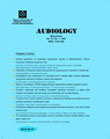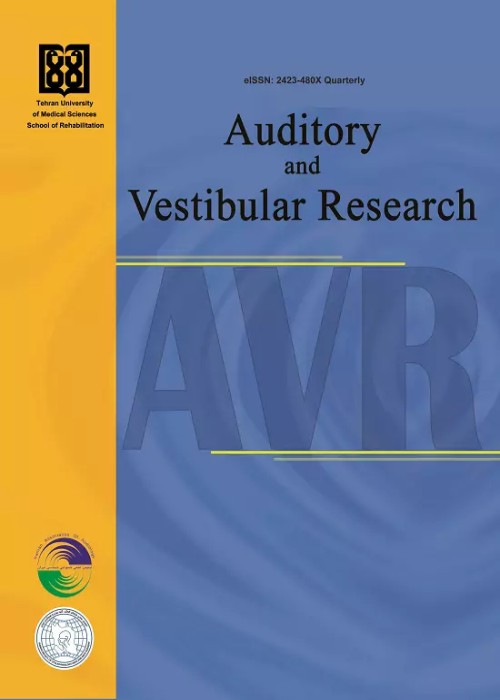فهرست مطالب

Auditory and Vestibular Research
Volume:10 Issue: 2, 2000
- تاریخ انتشار: 1381/06/20
- تعداد عناوین: 7
-
صفحات 4-8هدفغربالگری شنوایی نوزادان به عنوان یکی از بهترین روش های شناخت زود هنگام اختلال شنوایی و در پی آن اقدام به موقع برای پیشگیری از عوارض آن و در صورت امکان و نیاز، انجام توانبخشی مناسب.مواد و روش هاپژوهش حاضر روی 175 نوزاد 7 – 0 روزه (گروه اول 112 مورد با تاریخچه سلامت و گروه دوم 638 مورد با سابقه خانوادگی در رده پرخطر) در بیمارستانهای میرزا کوچک خان، بهارلو، و شهید اکبر آبادی تهران انجام شده است. صدا سازهای مورد استفاده طبل (برای تولید فرکانس های پایین) و رسیور (فرکانس های بالا) با شدت dBSPL 95-90 بوده اند و پاسخ مطلوب رفلکس پلکی گوشی (APR)، استارتل، توقف حرکات بود.یافته هااز گروه اول 51% APR، 10% رفلکس استارتل، 22% هر دو رفلکس را نشان دادند و 17% هیچ پاسخی نداشتند. از گروه دوم 47% APR، 24% رفلکس استارتل و 11% هر دو رفلکس را داشتند و 18% بدون پاسخ بودند.بحث و نتیجه گیریاز کل نمونه های مورد مطالعه (175 نوزاد) 14 نفر (8 دختر و 6 پسر) هیچ پاسخی نداشتند.
-
صفحات 9-14OAEs صداهای ایجاد شده در حلزون است که از کانال گوش خارجی دریافت می شود. وجود OAEs به عملکرد تقریبا طبیعی ارگان کورتی و سلامت گوش میانی بستگی دارد. صداهای ایجاد شده توسط حلزون بسیار ضعیف اما قابل شنیدن هستند. دامنه آنها ممکن است تا 30 dBSPL باشد. OAEs ممکن است بصورت خودبخودی ظاهر شود لیکن اغلب بدنبال تحریک صوتی ثبت می شوند و برای دریافت این پاسخها بجای الکترود از میکروفن استفاده می شود.
-
صفحات 15-20پارامترهای OAEs علاوه بر فرکانس وسطح محرک و وضعیت ساختارهای صدور ارتعاشات درگوش داخلی به خصوصیات و ویژگی های راه های انتقال صوت نیز بستگی دارد. در نتیجه غیر طبیعی بودن OAEs همیشه نشان دهنده غیر طبیعی بودن حلزون نیست. گوش میانی ارتعاشات را در دو راستا منتقل می کند: انتقال رو به جلو (از کانال گوش به حلزون) و انتقال به عقب یا برگشت صوت (از حلزون به مجرای گوش). بیماری های گوش میانی هر دو انتقال را تحت تاثیر قرار می دهند.
در این مقاله هدف بررسی اثرات آنی تغییرات فشار تمپان بر OAE برانگیخته شده با کلیک در افراد سالم می باشد. تغییرات فشار محیطی در یک اتاق فشار بر روی افرادی که از نظر شنوایی و گوش میانی سالم بودند اعمال شد. فشار تدریجا در گامهای dapa 100 برای افزایش و کاهش فشار تمپان تغییر یافت و از توازن فشار گوش میانی در حین آزمایش اجتناب شد. فشار نسبی بالا و پایین (dapa 320) حفره تمپان از طریق تمپانومتری پیگیری و CEOAE ها در هر گام از تغییر فشار ثبت گردید که در ثبت CEOAE در طی فشار تدریجی بالا و پایین، دامنه کمتر و زمان نهفتگی های کوتاهتری بدست آمد که اغلب در باند فرکانسی 750 تا 3000 هرتز چشمگیر بود.
کلیدواژگان: گسیل های صوتی گوش برانگیخته شده با کلیک، فشار حفره تمپان - گوش میانی -
صفحات 21-25برای آن که شیرخواران و کودکان کم شنوا به رشد طبیعی گفتار و زبان دست یابند باید بتوانند گفتار را خوب و کامل بشنوند. امروزه، کودکان با هر میزان کاهش شنوایی، کاندیدای دریافت انواع وسایل تقویت کننده هستند. از آنجا که کودکان با بزرگسالان تفاوت دارند. باید در انتخاب، ارزیابی و تنظیم و تطبیق سمعک آنها عوامل متعددی را در نظر گرفت. بطور مثال از چه سنی کودک کاندیدای دریافت سمعک سفارشی است؟ آیا در این گروه می توان از سمعک های قابل برنامه ریزی استفاده کرد؟ آیا سمعکهای چند حافظه ای مناسب هستند؟ سمعکهای دارای میکروفن جهت دار چطور؟ چه نوع سمعکی بهتر است برای کودک انتخاب شود؟ در این مقاله به پرسش هایی از این قبیل پاسخ داده می شود.
-
صفحات 26-31یکی از موضوعاتی که هنگام تجویز سمعک در مورد تقریبا تمامی بیماران نیازمند سمعک مطرح می شود، انتخاب یک گوشی بودن و یا دو گوشی بودن فیتینگ است. براساس مطالعاتی که توسط محققین مختلف گزارش شده است، فیتینگ دو گوشی مزیتهای قابل توجهی بر فیتینگ یک گوشی دارد. بسیاری از قابلیتهای بالقوه سیستم شنوایی تنها در سایه وجود سمعک در هر دو گوش متجلی می گردد. اهمیت فیتینگ دو گوشی بگونه ای است که در بسیاری از بیماران و در جمعیتهای خاص می تواند شکل گیری بسیاری از توانایی های سیستم شنوایی نظیر مکان یابی، تضعیف دو گوشی نویز را بطور جدی تحت تاثیر قرار دهد. اطلاع از مبنای علمی و اصول کاربردی این مبحث امری لازم و ضروری است. در مقاله حاضر به اجمال به این موضوع پرداخته شده است.
کلیدواژگان: شنوایی دو گوشی - فیتینگ دو گوشی، نسبت سیگنال به نویز، عدم تقارن اکتسابی در سطوح فوق آستانه -
صفحات 32-39آموزش یکپارچگی شنیداری (AIT) نوعی آموزش تقویت شنوایی است که در درمان برخی اختلالات ورودی حسی نظیر اتیسم، اختلال بیش فعالی نقص توجهی (ADHD)، ناتوانی در خواندن، بیش فعالی، ناتوانی های یادگیری (LDs)، نقایص زبانی، اختلالات رشدی فراگیر (PDD)، اختلال پردازش شنوایی مرکزی (CAPD)، اختلال نقص توجهی (ADD) افسردگی و حساسیت بیش از حد نسبت به صدا کاربرد دارد. این روش درمانی، چند سالی است که در ایالات متحده رواج یافته، و از زمان انتشار کتاب (1991) The sound of Miracle توسط خانم Annabel Stehli مورد توجه بسیاری قرار گرفته است. در این کتاب، خانم Stehli، تجارب مربوط به قبل و پس از استفاده از AIT را برای دختر 4 ساله اش که مبتلا به اوتیسم تشخیص داده شده بود، شرح داده است (33و24).
کلیدواژگان: اموزش تلفیق شنیداری - تربیت شنوایی، آموزش تقویت شنوایی - آموزش تلفیقی حسی -
صفحه 1
-
Pages 4-8ObjectiveInfants hearing screening as one of the best methods of identification and hence early intervention to prevent side effects and appropriate rehabilitation if necessary.Methods and Materials: 175 0-7 day infants were tested in two groups (112 normal history and 63 high risked) with a dumb (for low frequencies)and receiver (for high Frequencies) at 90-95 dB SPL in three hospitals. The acceptable responses were auropalpebral reflex (APR), startle and stop of movements.ResultsOf the first group 51% showed APR, 10% startle, 22 % Both and 17% no response. Of the second group 47% showed APR, 24% startle, 11% both reflexes and 18% no response.Conclusion14 cases (8 girls and 6 boys) out of 175 infnats showed no response.Keywords: Hearing Screening Program, Auro Palpebral Reflex, Startle Reflex, High Risk Registered Children, Visual Reinforcement Audiometry
-
Pages 9-14OAEs are sound founds in the external aditory meatus that originate in the cochlea. OAEs are generated only when the organ of corti is in near normal condition and They can be detected only when the middle ear system is operating normally. The sound generated by the cochlea are small but potentially audible, sometimes as much as 30 dBSPL. They can emerge spontaneously in the cochlea, but more commonly OAEs follow acoustic stimulation. No electrod are needed to observe OAEs. In fact, microphone are used to detect them.Keywords: Otoacoustic Emissions, Spontaneous Otoacoustic Emissions, Transient Evoked OtoAcoustic Emissions
-
Pages 15-20In addition to Stimulus frequuncy and level, emitting Inner ear structurs status, OAEs parameters depend on conductive sound pathways charactristics, so abnormal OAEs donot always represent cochlear abnormality. Middle ear transmites Vibrations in two directions: forward and backward. Middle ear pathologies affect both forward and backward transmission.In this paper, The purpose is investigation of immediate effects of tympanic over - and under - pressure on click evoked Otoacoustic Emissions (CEOAEs) in healthy individuals. Healthy subjects with normal hearing and middle ear were exposed to ambient pressure changes in a pressure champer. The pressure was progressively changed in 100 dapa steps to accomplish on increase and decrease in tympanic pressure. Pressure equilibration of the middle ear was avoided. The relative tympanic over-and under - pressure (+/-320 dapa) was monitored by tympanometry and CEOAEs recorded at every step of tympanic pressure change. The CEOAEs recorded during progressive tympanic over-and under- pressure had reduced amplitude and shorter latencies that were most pronounced in the 750 to 3000 Hz frequency bands.Keywords: Click, evoked Otoacoustic Emissions, Tympanic pressure, Middle ear
-
Pages 21-25In order to develop oral communication, hearing impaired infants and young children must be able to hear speech comfortably and consistently. To day children with all degrees of hearing loss may be condidates for some kinds of amlification.As children differ from adults, many Factors should be consider in hearing aid selection, evaluation and fitting. For example the child age when he or she is candidate for custom instruments? Do we consider programmable Hearing aid? Are multi memory instruments appropriate for them? What about directional microphones? What style of hearing aid do we select? In this paper such questions are responded.Keywords: Hearing Aid, Custom Hearing Aids, Directional Hearing Aids, Children, neonates, Desired Sensation Level, Wide Dynamic Range Compression
-
Pages 26-31One of the most important issue for selecting and fitting of hearing aids that should receive special attention is binaural amplification.According to several investigations, superiority of binaural amplification on monaural one is confirmed.Binaural Amplification may have considerable effects on fromation and developing of superior dimensions of hearing including: Localization, Binaural squelch (Better hearing in presence of noise).So, it is necessary to know the basic and scientific concepts and applicable principles of binaural hearing and binaural fitting.Present paper deals with this important subject.Keywords: Binaural heraing, Binaural squelch, Binaural amplification, Acquired suprathreshold asymmetry
-
Pages 32-39Auditory integration training (AIT) is a hearing enhancement training process for sensory input anomalies found in individuals with autism, attention deficit hyperactive disorder, dyslexia, hyperactivity, learning disability, language impairments, pervasive developmental disorder, central auditory processing disorder, attention deficit disorder, depressin, and hyperacute hearing. AIT, recently introduced in the United States, and has received much notice of late following the release of The Sound of a Moracle, by Annabel Stehli. In her book, Mrs. Stehli describes before and after auditory integration training experiences with her daughter, who was diagnosed at age four as having autism.Keywords: Auditory Integration Training, Auditory training, Auditory enhancement Training, Sensory Integration Training


